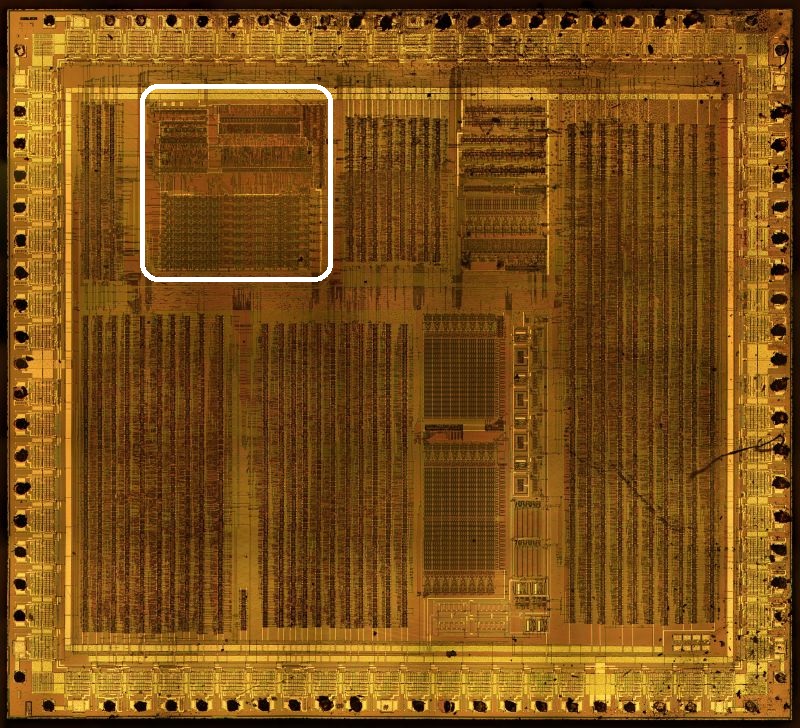DMG CPU Core
DMG-01 SM83 core research.
The core can be found here:

The B revision of the DMG SoC is being studied.
Basic Circuit Designs
The core consists of the following main components:
- The ALU (upper left corner), random logic (looking like “spaghetti”) and the flags register
- A decoder of three levels. Each level outputs a bunch of signals (
d,w,x) with a smaller number at each successive level. The main driving force for all the other parts is the set ofxsignals. Decoders are made as NAND/NOR trees + domino logic. - The sequencer occupies the right side and is built on “sort of” standard cells. Actually they are not cells in the usual sense, but “handmade” using standard modules and tweaking them a little bit in some places as required.
- At the bottom is part of DAA logic, the registers block, the SP, the PC and Incrementer/Decrementer. Also obviously there is a small circuit for interrupt control and a small but important circuit called the “Thingy”.

Gekkio Research
There is also an SM83 study by @Gekkio: https://github.com/Gekkio/gb-research/tree/main/sm83-cpu-core
All places where there is any parallel with his study (signal names) are marked as Gekkio.
Latest Progress
At the moment, the entire topology have been obtained. The basic circuit principles are understood and the transistor circuits of most of the modules are obtained. The main emphasis was made on the sequencer circuit, as the most demanded one.
The research has come to an end. It remains to check the correctness of the circuits in the HDL simulator.

Why SM83?
There is a manual from Sharp: https://archive.org/details/1996_Sharp_Microcomputer_Data_Book/page/n147/mode/2up
On page 148 of this PDF (or page 140 if you look at the original page numbers of the scan), it describes four microcomputers (SM8311, SM8313, SM8314 and SM8315). They all contain a CPU core that is labeled “SM83CPU” in the diagram on the next few pages, which has exactly the same instruction set and the same timings that the Game Boy CPU has. That is why we call the Game Boy CPU “SM83”. It seems to be the official name from Sharp for this core. I think @Gekkio found this originally, but I’m not sure. Before we knew about this document, most people called the CPU “LR35902”, because this was the label that was printed on the first batch of the rev. 0 chips. It seems to be that LR35902 is the name of the SoC as a whole, and SM83 is the name of the CPU core that was used inside. But I think we can’t be 100% sure that they really called this CPU SM83 back in 1989, or if they retroactively labeled it that when they reused it for those microcomputers in this 1996 data book.
by @msinger (Discussion #13)
Latch vs DFF vs DLatch vs FF
On this site we use the following conventions for terminology:
- Latch is a static memory element that responds to signal level (0/1)
- DFF is a static memory element which reacts to level change (1->0 aka negedge, 0->1 aka posedge)
- At the same time “FF” (FlipFlop, no D) - we call 2 elements (usually
notornor) cyclically closed to each other and used as a static memory cell. - DLatch is a dynamic memory element, which is stored on the FET gate. If it is not refreshed periodically, the value “fades away”.
You may have heard other definitions on other sites/Wikipedia, but they are different everywhere (depending on the context), so we clearly define them.
- Static memory elements: they store their value always and “forever”, regardless of whether the CLK changes or not
- Dynamic memory elements: they store their value on the FET gate, so they can get “corrupted” if not refreshed for a long time
Signals Disclaimer
I understand that everyone wants the signals to be called by human-readable and proper names. The SM83 study was conducted at different times, so sometimes you can see strange signal names.
Do not expect that all of them are quickly renamed to proper names. Such a process runs the risk of turning the study into signal renaming and nothing more.
From experience - frequent renaming of signals also contributes to various errors and confusion.
Renaming a signal does not make it work differently :smiley:
EDIT: This is the last project in which I accept signal name corrections. All subsequent ones will have a big sign at the beginning that signal corrections are not accepted.